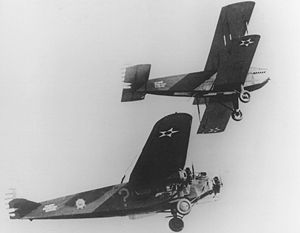Question Mark (airplane)
| Question Mark | |
|---|---|
 |
|
| Question Mark (below) being refuelled by a Douglas C-1 (above) | |
| Type | Atlantic C-2A |
| Manufacturer | Atlantic Aircraft Corporation |
| Serial | 28-120 |
| First flight | 1928 |
| Owners and operators | United States Army Air Corps |
| In service | 1928–1932 |
| Fate | Converted to Atlantic C-7 in 1931 and scrapped at Randolph Field in 1934 |
Question Mark ("?") was a modified Atlantic-Fokker C-2A transport airplane of the United States Army Air Corps. In 1929, commanded by Major Carl A. Spaatz, it was flown for a flight endurance record as part of an experiment with aerial refueling. Question Mark established new world records in aviation for sustained flight (heavier-than-air), refueled flight, sustained flight (lighter-than-air), and distance between January 1 and January 7, 1929, in a non-stop flight of more than 150 hours near Los Angeles, California.
Following the record-setting demonstration the C-2A was returned to transport duties. In 1931 more powerful engines replaced those used in the endurance flight and it was re-designated as a C-7 transport. The aircraft was damaged beyond economical repair in 1932 when it crash-landed in Texas after running out of fuel and was scrapped.
The flight demonstrated the military application of the concept but while it inspired numerous efforts to set even greater endurance records, development of a practical in-flight refueling system was largely ignored by the world's air forces before World War II. Civilian development of aerial refueling in Great Britain was more successful, but in the end it too was disregarded. However, Spaatz, two decades after the flight of the Question Mark, became head of the United States Air Force and using the British system as a starting point, implemented in-flight refueling on a worldwide operational basis.
The first complete inflight refueling between two aircraft took place on June 27, 1923, when two Boeing-built de Havilland DH-4Bs of the United States Army Air Service accomplished the feat over San Diego's Rockwell Field. Subsequently, the same group of airmen established an endurance record of remaining aloft for more than 37 hours in August 1923, using nine aerial refuelings. In June 1928, a new endurance record of more than 61 hours was established in Belgium by Adjutant Louis Crooy and Sgt. Victor Groenen, also using aerial refueling.
...
Wikipedia
